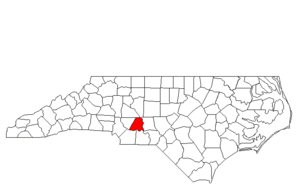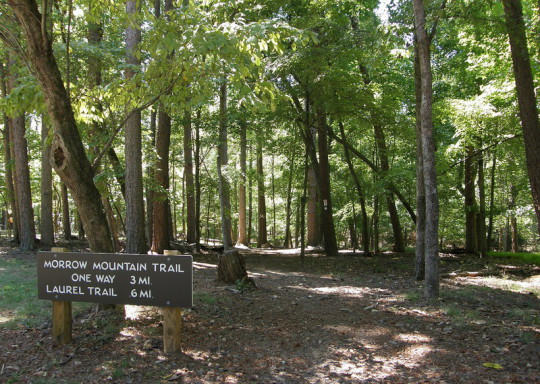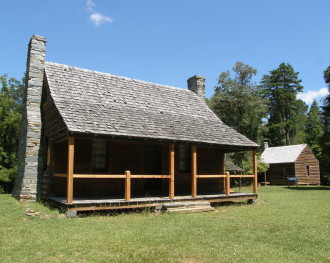STANLY COUNTY
Scroll down this page or click on site name to view features on the following Stanly County attractions/points of interest:
Fast facts about Stanly County:
Created in 1841, the county is named for John Stanly, a Speaker of the NC House of Commons and a US Congressman.
The county seat is Albemarle, named for George Monck, duke of Albemarle and one of the Lords Proprietors. Other communities include Badin, Locust, Misenheimer, New London, Richfield, and Stanfield.
Stanly County’s land area is 395.06 square miles; the population in the 2010 census was 60,585.
Albemarle
Morrow Mountain State Park, six miles east of Albemarle, offers a variety of recreational opportunities, from hiking, horseback riding, and camping to swimming, boating, and fishing. The park covers nearly 4,700 acres of the Uwharrie Mountains range, which runs north to south across Randolph, Montgomery, and Stanly counties. Since the entire eastern edge of the park is bounded by water – the Pee Dee River and Lake Tillery – it is only natural that many of the activities it offers are water related. Fishing is a popular pastime along the riverbanks or on the lake, with perch, catfish, bluegill, and bass being common catches. Boating is another favorite activity. Rowboats and canoes are available for rent at the boathouse at the northern end of the park. For those with their own craft, a boat ramp is located in the same area. From June to Labor Day, a large swimming pool is open to the public for a nominal fee, and there is a smaller pool for the younger children. The stone bathhouse, built by the Civilian Conservation Corps and Works Project Administration during the late 1930s, provides convenient changing rooms, showers, restrooms, and concessions.
The Bridle Trail is an equestrian’s delight, offering a 16-mile route that encircles the park under a canopy of towering oaks, pines, and poplars. A variety of hiking trails range in length from .06 mile to over four miles. The majority of hiking trails are easy walks, some are moderate, and two are deemed strenuous. All are well marked. For those not interested in walking the 3-mile Morrow Mountain Trail to the summit, a 3-minute drive will take you to the top, where overlooks provide wonderful views to the east, west, and south. A mountaintop marker recognizes the contributions of James McKnight Morrow (1864-1941), whose donation of over 1,800 acres, including Morrow Mountain itself, helped make the state park possible.
Campsites for tents and RVs are available for overnight guests; each site in the family campground features a picnic table and grill. Restrooms and showers are conveniently located. The park has six vacation cabins available for rent on a weekly basis during the summer months and for two-night weekend stays in the spring and fall. Each cabin has two bedrooms, a kitchen with dining space, a living room with fireplace, and a bathroom. For more rugged individuals, the park also has a primitive campground in a secluded area about a two-mile hike from the park office. Drinking water and supplies must be carried to the site, and no fires are permitted.
Complementing the park's natural attractions is the recreated homestead – farm house, medical office, and greenhouse – of Dr. Francis Kron. A native of Prussia, Kron and his wife Mary immigrated to the States in the 1820s, eventually reaching the home of Mary’s uncle in Montgomery County, North Carolina. For a time, Kron taught French at the University in Chapel Hill. After attaining a medical degree at the University of Pennsylvania, he returned to North Carolina, settling in the rolling hills of the Uwharrie Mountains at a point near the Salisbury-to-Fayetteville market road and the ferry service crossing the Pee Dee River. Kron was the first formally trained doctor in North Carolina’s southern piedmont and he became a local legend as he traveled miles on horseback or by wagon to treat patients. Dr. Kron was also a key figure in the formation of Stanly County in 1841 and in the establishment of the county’s public schools. The park also includes a small exhibit hall with displays pertaining to plant and animal communities, rocks and minerals, American Indians, and European settlement. The park is open year round. Hours vary seasonally. The exhibit hall is open 10-5 daily; the Kron House is open Sundays during the summer from 2-3 PM. For park fees, rental information, and hours, call 704-982-4402.
Albemarle
The Stanly County Museum in downtown Albemarle presents regional history by means of two historic houses and a modern exhibit hall. The museum building, which opened in 1996, makes good use of its small space, presenting vintage photographs, artifacts, and informational placards in well-organized showcases devoted to such topics as Indian culture, early European settlement, industrial growth, education, and war. A convenient reference booklet obtained at the entrance allows visitors to look up additional information on any items on display that catch their interest. Museum visitors will learn that Stanly County was created in 1841, separated from Montgomery County along the natural dividing line formed by the Yadkin River. The community that had blossomed around the intersection of the turnpike road from Fayetteville to Salisbury and the stage road connecting Raleigh and Charlotte became the county seat and named Albemarle. The county itself was named for John Stanly, a popular North Carolina statesman during the early 19th century. Stanly is perhaps best remembered for having been a participant in the last legalized duel in state history, during which encounter political rival Richard Dobbs Spaight, Sr., former North Carolina governor, was killed. Also told is how the efforts of a French company, L’Aluminum Francais, to dam the Yadkin River in 1913 led to the establishment of a company town named Badin, for company president Adrien Badin. With the outbreak of World War I, the French redirected their energies to support the war effort in Europe, after which the Aluminum Company of America (Alcoa) assumed responsibility for the project and the town. Alcoa has been a lynchpin of the county’s economy since 1915.
The 1835 Freeman-Marks House stands on a hill a short distance behind the museum building. It is the oldest home in Albemarle, moved to its present lo-cation in 1975 when the building was donated to the Stanly County Historic Preservation Commission. Restoration of the simple Federal-style hall-and-parlor home took over ten years to complete before the house was opened to the public in 1986. Typical 19th century furnishings are on display. Two rooms added to the rear of the house served as office space for the doctors and lawyers who occupied the house from 1847-1884.
The 1852 Isaiah Snuggs House is Albemarle’s third oldest home, and this one still stands on its original site. Snuggs was Stanly County’s sheriff when he bought the house in 1873. At that time it stood across the street from the courthouse and jail. Originally a simple one-room cabin, the sheriff enlarged the home considerably, adding a second floor and several rooms downstairs. The Preservation Commission acquired the house in 1974, and two years later opened it as the first home for the Stanly County Museum. Today the downstairs rooms are used to display items of interest to children – antique books, toys, and games – while the parlor and bedroom upstairs are filled with period furnishings. Family portraits grace the walls. Be sure to ask the tour guide why a bomb has been placed at the front corner of the property. The Museum complex is located at 245 East Main. Hours are 8:30-5 Monday-Friday, and 10-2 the first Saturday of each month. Admission is free; donations accepted. House walk-throughs are available by request. 704-983-7316
Stanly County is bordered by ANSON, CABARRUS, DAVIDSON (Region Six), MONTGOMERY, and UNION counties.
Return to REGION SEVEN HOME PAGE.
Return to GEOGRAPHIC REGIONS HOME PAGE.










